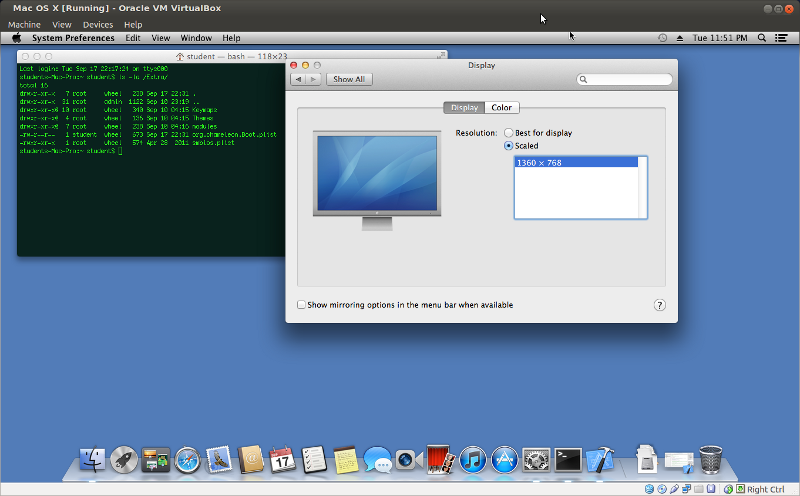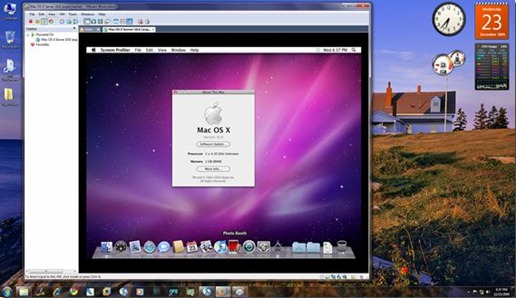

Now, you’re going to start up Ubuntu Linux by typing “sudo startunity.”.Then, you’ll get the script to execute itself by typing “sudo sh ~/Downloads/change-kernel-flags” and pressing “Enter” on your Chromebook keyboard.Then, type “wget ” and press “Enter” on your Chromebook keyboard.Next, type “shell.” Then, download the script that someone already wrote to make this process easier.Press “ctrl + alt + t” on your Chromebook’s keyboard, which in turn opens Crosh in a new tab of your Chrome Browser.
#MAC OS X VM HOW TO#
♦ How to Install VMware Tools on Mac OS Mojave 10.To install the Ubuntu distribution of Linux, you will first need to get into the Chrome OS developer shell, Crosh. ♦ How to Install Mac OS Mojave 10.14 on VMware ♦ How to Install Mac OS Mojave 10.14 on a Mac Thanks for following us! Related Articles In the next article, we will install Mac OS 10.13.5 with Oracle VM VBox.
#MAC OS X VM WINDOWS 10#
In this article, we have reviewed the stages for setting up the macOS VM on Oracle VM VirtualBox on the Windows 10 operating system. You can see from the image below that the macOS VM has started successfully. Now you can run the macOS virtual machine and start the installation. The CMD command prompt will open and the commands will execute within a few seconds. Run the Code.cmd file as an administrator.

VBoxManage setextradata " Your Virtual Machine Name" "VBoxInternal/Devices/smc/0/Config/GetKeyFromRealSMC" 1Ĭhange the extension of the file to. VBoxManage setextradata " Your Virtual Machine Name" "VBoxInternal/Devices/smc/0/Config/DeviceKey" "ourhardworkbythesewordsguardedpleasedontsteal(c)AppleComputerInc" VBoxManage setextradata " Your Virtual Machine Name" "VBoxInternal/Devices/efi/0/Config/DmiBoardProduct" "Iloveapple" VBoxManage setextradata " Your Virtual Machine Name" "VBoxInternal/Devices/efi/0/Config/DmiSystemVersion" "1.0" VBoxManage setextradata " Your Virtual Machine Name" "VBoxInternal/Devices/efi/0/Config/DmiSystemProduct" "iMac11,3" VBoxManage.exe modifyvm " Your Virtual Machine Name" -cpuidset 00000001 000106e5 00100800 0098e3fd bfebfbff Write your VM name to the Your Virtual Machine Name section! cd "C:\Program Files\Oracle\VirtualBox\" Select the macOS High Sierra ISOfile and click the Open button.Ĭlick the OK button to close the Mac OS VM settings window.Ĭopy and paste the following commands into the text document before running the VM, and then click File to save the file with a different extension.
#MAC OS X VM ISO#
To add the ISO file to the macOS High Sierra VM, click Chose Virtual Optical Disk File. Remove the Floppy device in the Boot Order section.įor the macOS High Sierra VM, configure 2 processors on the Processor tab.Īfter you click on the Display tab and then on the Screen tab, configure the Video Memory value to 128 MB. In the macOS VM settings window, click System and then Motherboard. Once the macOS High Sierra VM has been created, click the Right Button on it and select Settings from the window opened.

Click the Create button to create a VM hard disk. You can configure the virtual hard disk size to 30 GB.

#MAC OS X VM PORTABLE#
Select your Portable Hard Disk and create a new folder for the VM and click the Open button on the folder.Ĭlick the Save button to save the virtual hard disk of the Mac OS High Sierra. To change the HDD location of the VM, click on the symbol you see in the image below. Storing the hard disk of the macOS VM in a different location is useful for performance. Select the desired option and click on the Next button. For performance, you can configure a hard disk backup type of a VM as Fixed Size. So when you install a program on the VM your disk will expand automatically.įixed Size: The VM will configure the hard disk size before installing, but this will take some time. Dynamically allocated: Quickly create a virtual hard disk and use as much space as needed on your hard disk.


 0 kommentar(er)
0 kommentar(er)
